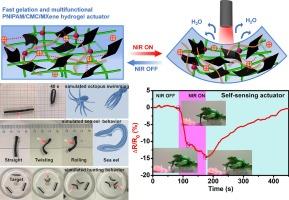Fast fabrication of stimuli-responsive MXene-based hydrogels for high-performance actuators with simultaneous actuation and self-sensing capability
IF 9.7
1区 化学
Q1 CHEMISTRY, PHYSICAL
引用次数: 0
Abstract
Poly(N-isopropylacrylamide) (PNIPAM) composite hydrogels have recently emerged as promising candidates for soft hydrogel actuators. However, developing a facile and fast method to obtain multifunctional PNIPAM hydrogel actuators with simulating biological versatility remains a major challenge. Herein, we developed a fast-redox initiation system to prepare PNIPAM/sodium carboxymethyl cellulose (CMC)/T3C2Tx MXene nanocomposite hydrogel with multidirectional actuating behaviors and improved mechanical properties. The rapid thermoresponsive behavior of the PNIPAM/CMC/MXene layer bestows its corresponding bilayer actuator with an extraordinary actuation speed of 9.36°/s in hot water. Owing to the high photothermal conversion of MXenes, this PNIPAM/CMC/MXene hydrogel displays a range of remote-controlled actuations upon NIR light irradiation, including bending, rolling, displacement, and simulations of the sea eel’s hunting behaviors in a water environment. More importantly, based on the excellent electrical properties of MXene, the PNIPAM/CMC/MXene-based hydrogel actuators have accomplished a self-sensing function by integrating the surface temperature-bending angle-the relative resistance changes during the NIR light-driven actuation process. The photothermal actuator’s integrated actuation and sensing capabilities have facilitated the feedback of the contact and movement dynamics of the bioinspired artificial tongue. The straightforward preparation and multifunctional design of MXene-based hydrogel may facilitate the development of soft smart actuators.

具有同步驱动和自传感能力的高性能致动器的刺激响应mxeni水凝胶的快速制造。
聚(n -异丙基丙烯酰胺)(PNIPAM)复合水凝胶最近成为软水凝胶致动器的有前途的候选材料。然而,开发一种简单快速的方法来获得具有模拟生物多功能性的多功能PNIPAM水凝胶驱动器仍然是一个主要挑战。在此,我们开发了一种快速氧化还原引发体系,制备了具有多向驱动行为和改善力学性能的PNIPAM/羧甲基纤维素钠(CMC)/T3C2Tx MXene纳米复合水凝胶。PNIPAM/CMC/MXene层的快速热响应特性使其相应的双层致动器在热水中具有非凡的9.36°/s的致动速度。由于MXene的高光热转换,这种PNIPAM/CMC/MXene水凝胶在近红外光照射下显示了一系列遥控动作,包括弯曲、滚动、位移和模拟海鳗在水环境中的狩猎行为。更重要的是,基于MXene优异的电学性能,基于PNIPAM/CMC/MXene的水凝胶致动器通过集成近红外光驱动致动过程中的表面温度-弯曲角-相对电阻变化,实现了自传感功能。光热致动器的集成驱动和传感能力促进了仿生人工舌的接触和运动动力学反馈。基于mxene的水凝胶制备简单,设计功能齐全,可促进柔性智能执行器的发展。
本文章由计算机程序翻译,如有差异,请以英文原文为准。
求助全文
约1分钟内获得全文
求助全文
来源期刊
CiteScore
16.10
自引率
7.10%
发文量
2568
审稿时长
2 months
期刊介绍:
The Journal of Colloid and Interface Science publishes original research findings on the fundamental principles of colloid and interface science, as well as innovative applications in various fields. The criteria for publication include impact, quality, novelty, and originality.
Emphasis:
The journal emphasizes fundamental scientific innovation within the following categories:
A.Colloidal Materials and Nanomaterials
B.Soft Colloidal and Self-Assembly Systems
C.Adsorption, Catalysis, and Electrochemistry
D.Interfacial Processes, Capillarity, and Wetting
E.Biomaterials and Nanomedicine
F.Energy Conversion and Storage, and Environmental Technologies
文献相关原料
公司名称
产品信息
阿拉丁
Iron chloride hexahydrate
阿拉丁
Ligninsulfonate sodium (LS)
阿拉丁
Methylenebisacrylamide (MBAA)
阿拉丁
Acrylamide (AAM)
阿拉丁
Ammonium persulfate (APS)
阿拉丁
Polyethylene glycol diacrylate (PEGDA)
阿拉丁
N-isopropyl acrylamide (NIPAM)
阿拉丁
Sodium carboxymethyl cellulose (CMC)

 求助内容:
求助内容: 应助结果提醒方式:
应助结果提醒方式:


